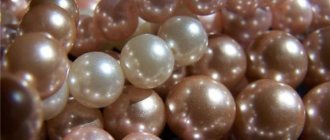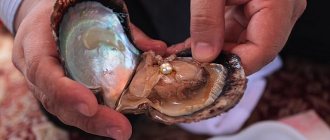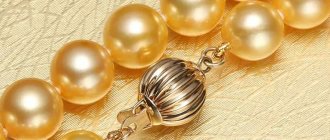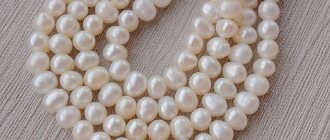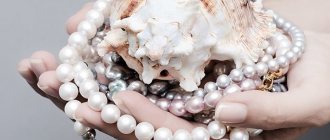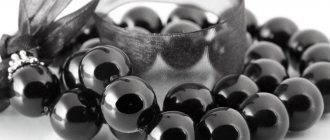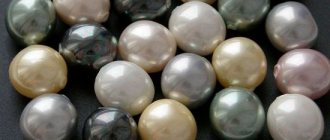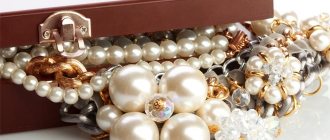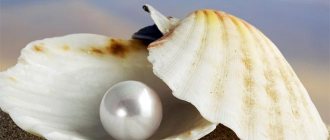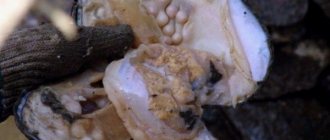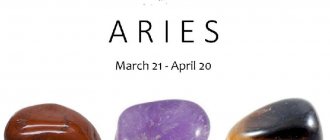Water and the caring embrace of a mollusk create a flawless creation from a grain of sand and mother-of-pearl - a pearl. However, nature is leisurely, and people want more and faster. In order to preserve a healthy ecological environment in the world, the harvesting of pearl oysters has been prohibited since 1952: that is why cultured pearls were invented.
Cultured pearls
What are cultured pearls
Cultured stone is similar in its properties and characteristics to natural pearls. However, it is produced under man-made conditions.
A distinction should be made between artificial pearls and cultured pearls. In the first case, stones are made at a factory from glass or plastic, and then coated with special dyes. This variety is not classified as a precious mineral. Artificial beads are used to create jewelry or as a decorative element.
A natural mineral is formed as a result of a foreign body entering the shell. The mollusk secretes a special secretion that envelops the traumatic agent. The result is a rounded stone. The longer the pearl stays in the shell, the larger its size. Sometimes the pearl ball grows to gigantic sizes.
Thus, a specimen weighing about 6 kg was found near the island of Palawan.
Cultured pearls are produced on special farms. Conditions identical to natural ones are created. To improve the quality of the stone, a special type of mollusk (Pinctada or Pteria) is selected. A grain of sand is placed in the shell and processed by the oyster for several years.
About the types of pearls, see a brief overview:
Saltwater cultured pearls
Saltwater cultured pearls are large in size and have an ideal core shape. In this case, a stable temperature and a certain salinity of water are important. Otherwise, the mussel will die.
Pearl is formed as a result of the introduction of a grain of sand into the reproductive apparatus of a mollusk. After just 2 years, a pearl of proper quality is formed. From 1 to 3 stones are removed from the shell.
This method is extremely dangerous for the oyster. A large proportion of mollusks die in the first year of formation. Some individuals reject the foreign body. If this does not happen, the pearl matures over the course of several years.
Freshwater river cultured pearls
The creation of freshwater cultured pearls is fundamentally different. In this case, a fragment of mother-of-pearl is placed not in the reproductive organs, but in the mantle of the mollusk. In this case, up to 20 nuclei can form in one shell.
This mineral grows in fresh water or in flooded rice fields. These conditions are most favorable for mollusks. They contribute to their growth, development, and reproduction.
The price of river stone is lower. Most minerals are small in diameter and irregular in shape.
Read about natural freshwater pearls here.
View this post on Instagram
Publication from JEWELRY? EARRINGS?BRACELETS (@nastasia_olesandr) May 21, 2021 at 10:34 PDT
Growing technology
Cultivated formations are highly valued for their practicality and relatively low cost. But growing pearls is a complex, labor-intensive and lengthy process that takes several years and requires a careful and caring approach. The human factor largely determines the quality of the pearl oyster kernel.
Despite the efforts and desires of farmers, it is not always possible to achieve a positive result. The difficulty is that it is impossible to predict the exact time of rejection of shellfish peas, as well as the percentage of their rejection. Because of the painstaking nature of this work, it is sometimes compared to jewelry making. There are 2 methods of pearl cultivation: nuclear and non-nuclear.
Nuclear
This technology for growing sea pearls is based on a specific algorithm of actions. It all starts with the choice of a “donor” shell; preference is given to young, healthy mollusks. They must have a mantle that meets the standards, that is, a mother-of-pearl shell, this is the main requirement when choosing. No less important is the condition of the gonad - the reproductive organ of the mollusk, on which the high-quality formation of mother-of-pearl balls depends.
Then everything happens as follows:
- The sink doors are carefully opened. To avoid damaging it, use special tools.
- Using a medical scalpel, a shallow longitudinal incision is made in the soft tissues of the mollusk.
- A piece of mother-of-pearl shell and a freshwater oyster ball are placed into the incision and placed next to the donor mantle.
- The shell is closed and immersed in salty sea water for 2-3 years, without interfering with the process.
Even if everything is done correctly, the desired result is not guaranteed. During growth, premature rejection of the nucleus often occurs, after which the mollusk dies. If the formation process proceeds properly, during each year the cultured pearl adds 1 cm of nacre coating.
Nuclear-free
Using this most common technology, growing freshwater or river pearls is not particularly difficult. It is not too different from nuclear, except for the use of tiny grains of mother-of-pearl sand. Cultivation takes place mainly in river or lake water.
In China, the process takes place in flooded rice fields, where first-class precious minerals are obtained.
However, pearls are often grown in sea lagoons. In this case, the process of education using nuclear-free technology is different. Temperature and acidity indicators of water are of primary importance. Caring for the shells is important: they need to be turned over periodically to preserve the core and give the beads a perfect round shape. Pearls grown in this way are small, most are 8-9 mm, rarely exceeding 1 cm in size.
How are pearls grown?
Growing pearls is a long and labor-intensive process.
It includes the following steps:
- introduction of a nacre fragment into the body of a mollusk;
- placing the sink in special conditions (salinity and water temperature are strictly regulated);
- growing period (lasts from 2 to 5 years);
- removing a pearl from a shell.
Farms that grow cultured pearls are located everywhere. The leadership in this matter belongs to China and Japan. The products of these countries occupy almost the entire jewelry market.
In Russia, freshwater pearls are mainly cultivated. This is due to geological and climatic features. However, its cost is higher than in China, so it is not profitable to engage in pearl production.
There are opinions that the process of growing pearls is simple and can be done at home.
In China you can even buy shellfish and specialized aquariums. However, creating favorable conditions for the life of oysters is not easy.
The temperature and pH of the water must be carefully monitored. Otherwise, the pearl oyster will quickly die. In addition, even in comfortable conditions, almost half of the mollusks die. Therefore, this type of activity is unlikely to bring significant income.
Watch this educational video about this type of pearl:
How they acted in Japan
Large-scale work on pearl cultivation in Japan began only in the 19th century. The Japanese came up with the idea of “planting” a ready-made mother-of-pearl ball into the shell, creating living conditions for mollusks as close to natural as possible. The grafted shells were lowered into the sea in special structures that prevented contact with predators, algae and other living creatures.
Is it possible, adopting the experience of the Japanese, Swedes and Chinese, to try to grow at least one pearl at home in an aquarium? The experiment deserves attention, although it does not guarantee success.
What shape does the mineral have?
Cultured pearls can come in various forms. Irregularly shaped beads are most often found among freshwater cultured pearl specimens. They are small in size, their surface is rough, with small defects. The price of such a mineral is low.
Round stones are less common. As a rule, they are much larger. Their surface is smooth, without visible defects. These pearls are most likely grown in seawater.
What defects are acceptable and what are not?
The quality of cultured pearls is assessed by their shape, intensity of shine, and the presence of defects. The last point is the most important, as it determines the appearance of the stones. The mineral can be A, AA, AA+, AAA, B, C, D classes. Pearls belonging to groups B, C, D are considered low quality minerals and are not used in jewelry.
Pearl defects can be different. Most often there are depressions, rises, and spots. What matters is their degree of expression. They are absent in AAA class minerals; in AA+ and AA there are minor structural disturbances. Class A has pronounced defects that can be seen without a magnifying glass.
Minerals of B, C, D classes have disorders that affect the durability of the pearl, so their use is limited.
What did they come up with in China?
The first experiments on creating pearls using oysters in China were carried out back in the 13th century. Then the shells of young mollusks were carefully opened with tongs, grains of sand were inserted into the folds of the mantle and closed again. The shellfish with the “cargo” were placed in sea pens and waited for several years.
Unfortunately, at that time they did not know how to increase the percentage of surviving mollusks. Only 20% remained alive after the “operations,” and the pearls in the surviving shells did not always live up to expectations.
Types of cultured pearls
There are a huge number of varieties of cultured pearls. Their morphological differences are explained by growing conditions and the type of mollusk. As a result, pearls of various sizes, colors, and shapes are formed.
The most common varieties are:
- Akoya is a Japanese cultured pearl that is round in shape and medium in size. The color of the beads may vary. There are white, cream, pinkish specimens.
- Tahitian pearls are black varieties of cultured stone. Shades of mother-of-pearl vary from dark gray to copper and greenish. The size of the pearls is approaching large ones. The maximum diameter of the pearl is 20 mm.
- Gifts of the South Seas - cream or golden beads. Their diameter also ranges from 8 to 20 mm. The stones have a thick layer of mother-of-pearl (2-6 mm) and a satin shine.
- Cortez's pride has a rainbow tint. The pearls themselves have an average diameter and a relatively thin layer of nacre (about 2 mm). More often, pearls of cool tones are found: silver, dark gray or brownish.
- Kasumi is a type of freshwater cultured pearl. It has a teardrop or baroque shape. There are white, golden, lilac, cream shades.
- Keisha cultured pearls are bean-shaped. The beads have no core. Their surface is heterogeneous, there is a thick layer of mother-of-pearl. Bead colors may vary.
- Mabe is also distinguished by its shape. The outside of the bead is convex, the inside is flat. This occurs due to the introduction of an implant into the shell of the mollusk.
- Biwa is classified as a freshwater species. They have an oblong shape and a unique shine. Pearl colors: white, silver, cream, blue, greenish.
To view a photo gallery of stones:
Akoya
Tahitian pearls
Southern Pearl
Pride of Cortez
Kasumi
Keishi
Mabe
Biwa
The principle of pearl formation: basic
Spherical pearlescent inclusions inside the shell are formed in nature under the influence of a combination of circumstances. A foreign body enters the mollusk shell through the slightly open valves:
- grain of sand;
- small pebble;
- microorganism particle, etc.
Any object that gets inside poses a threat to the health and life of the mollusk. Therefore, the oyster turns on the instinct of self-preservation and begins to neutralize the object, enveloping it in layers of mother-of-pearl.
So, year after year, nacreous walls grow on an ordinary speck, and a pearl appears, the size of which depends on the length of time it stays in the shell.
Healing and magical properties
Ancient Chinese healers used pearl powder. Thanks to its high calcium content, it helped strengthen the bone and muscle system. The mineral also has a positive effect on the kidneys, liver, and intestines. It normalizes their work and helps cope with excessive accumulation of toxins in the body.
In addition, wearing a stone can reduce fatigue, nervous tension, and overcome stress and its consequences.
The main magical property of pearl is protection and fight against old age. Even Queen Cleopatra revered this stone. She regularly wore strings or rings of pearls to maintain her youth and beauty.
Pearls are a symbol of purity and purity. It was believed that if a bride was presented with a string of pearls, it would protect her from bad deeds and infidelity.
How long does it take for pearls to grow and mature?
Growing natural pearls on a farm or in the wild definitely takes time. The person himself regulates the duration of the bead maturation period, stopping the process at his own request. The sooner you open a mollusk shell, the thinner the layer of nacre will be on the pearl.
In general, the rate of growth and maturation depends on a number of important factors:
- age of the mollusk;
- place of stay;
- ecological situation.
A pearl in a sea shell will require the least amount of time. Over the course of a year, under favorable conditions, it will increase to an average of 2-3 mm. Then it will increase by 0.38 mm annually. Compared to river beads, sea beads are larger. This is noticeable even from the photo. The special biochemical composition of water is responsible for the size. River mollusks, meanwhile, as already noted, are less demanding on the number of pearls in the shell.
How to distinguish real pearls from artificial ones
The popularity and high cost of pearls determines the large number of artificial stones on the jewelry market. Often, only a jeweler can distinguish natural pearls from fake ones. However, anyone can identify low-quality imitation.
Visual inspection methods
Visual methods evaluate exclusively the morphological characteristics of stones.
These methods include analysis of the following indicators:
- color;
- weight;
- form;
- surface cleanliness.
Natural minerals often have irregular shapes. Spherical stones cost more. In addition, they are rare in both wild specimens and cultured pearls.
The color of the mineral can be varied. More often these are whitish, creamy shades. There are no bright or neon colored pearls. Most of them have a discreet color.
The surface of natural minerals contains small defects. Beads with an even layer of mother-of-pearl coating are very expensive.
If similar stones have a low price, it is most likely an imitation.
The weight of the stone is also important. Pearls are classified as heavy minerals. Glass and plastic beads are lighter than natural pearls.
View this post on Instagram
Publication from DESIGNER JEWELRY? (@galina.sa) Apr 26, 2019 at 7:02 PDT
Mechanical testing methods
Mechanical methods are not suitable for detecting counterfeits at the time of purchase, since all manipulations can damage or ruin the product.
Reliable ways to recognize imitation:
- Tooth check. Natural stone has low density and hardness, so if you bite it, the bead will begin to crumble. In addition, a characteristic creaking sound will be heard.
- Friction test: If you rub two beads together, a characteristic pearlescent powder will be released.
- Strength test: the bead is dropped onto a hard and flat surface. The imitation pearl will remain intact, unlike natural or cultured pearls. Natural stones will acquire new defects: scratches, chips, holes.
Physico-chemical method
These methods allow you to distinguish the original from the fake using the properties of natural mother-of-pearl.
Important to remember:
- The natural mineral has low thermal conductivity, so it warms up slowly from body heat.
- When tested under ultraviolet light, authentic samples will exhibit a bluish glow.
- Natural stones are relatively heat resistant. If you place a bead in a fire for a few minutes, it will not change.
- If you place a natural mineral in vinegar, it will dissolve in a couple of minutes.
Formal methods
The most relevant formal method is estimating the value of the stone. The price of a high-quality imitation with a diameter of about 1.5 cm is 2000 rubles. The cost of the same natural or cultured pearl is approximately $1,700.
If we are talking about an irregularly shaped stone, the price will be about $1000.
As for baroque or freshwater cultured pearls, their cost is not so high (about 2000 rubles per thread). Therefore, fakes are extremely rare. In addition, there are many defects on the surface of stones that are difficult to fake.
In addition to the topic, video review:
What types of shellfish to choose
Pearls are formed in the shells of several species of mollusks that live:
- in the seas;
- oceans;
- freshwater lakes;
- rivers and reservoirs.
Depending on the type of living organism, pearls have one or another color, features, and sizes.
Determine which shellfish are suitable for keeping in the aquarium. Consult a biologist.
Japanese akoya shells, for example, are sold in ready-made kits in aquariums, with instructions for growing, food and, most importantly, already “grafted”.
You can buy such sets only in Japan and again, there is no guarantee that they will feel normal at home in Russia. Its price is about $200, the supplements and food included in the package are designed for 60 days, so you will have to look for options for purchasing them separately. The Japanese believe that growing pearls is easy. All you need is suitable conditions and patience with the desire to succeed.
It is believed that pearls can even be obtained from the Black Sea mussel. You don’t have to travel far to get them, and it’s easier to create conditions in the aquarium that are identical to natural ones. But freshwater species of mollusks like Margaritifera Margaritifera will definitely not take root in an aquarium. For normal existence and development, they need a complex of specific microbiotopes of the river, which is almost impossible to recreate artificially.
Pearl grading
The stone is assessed according to the following criteria:
- presence of gloss;
- severity of defects;
- degree of coincidence in the product;
- form;
- mother of pearl thickness.
The criteria for classifying cultured pearls into a certain quality class are given in the table:
| Quality class | Criteria | ||||
| Gloss | Defects | Coincidence | Surface | Nacre | |
| A | + | Not expressed | + | Round | Average |
| AA | ++ | Absent in 80-90% | ++ | Spherical | Above average |
| AA+ | +++ | Absent in 90-95% | +++ | Less fat | |
| AAA | Absent in 95-99% | Thick | |||
The cost of a mineral depends on the quality class, size, color, shape. There are also differences in price gradation between types. For example, South Sea pearls are much more expensive than akoya.
How are price and frame related?
The price of cultured pearl jewelry depends not only on the quality class, but also on the metals used in the product.
- For example, the price of a silver ring with cultured pearls is 1500-2500 rubles.
- The same gold ring costs 10,000-20,000 rubles.
- The proportion of metal in necklaces and bracelets is small.
- The cost of a silver bracelet will be 3,000, and a gold bracelet will be 10,000-15,000 rubles.
The process of pearl generation - where to start
If you did not bring a ready-made kit for growing pearls in an aquarium from Japan, you will have to “introduce” the foreign body into the oyster yourself. This can be done immediately after the mollusks take root in the new place. Try implanting a small mother-of-pearl ball into the mantle of an open mollusk.
When the “processing” is completed, carefully close the pearl oyster and return it to the bottom. You won’t have to do anything further except continue to carefully care for the shellfish. You can check how the “implant” has taken root no earlier than after 3 years.
In conclusion, it remains to be noted that a home aquarium with mussels for creating pearls is not the best option. Those who think about organizing a full-fledged farming of pearl oysters in a natural environment will have much better chances.
We hope that the article was useful and that you made the right conclusions regarding whether it is worth trying to grow pearls at home. Share the material with your friends on social networks!
Team LyubiKamni
Marine cultivation
Precious minerals are grown by farmers. The method is the same, but the plantations are located on the open sea. This mineral is more valuable than freshwater. One shell can become home to several pearls. The largest number is three. The stones have the correct shape and a pleasant, delicate shine. The result is explained by the properties of sea salt water. Sea salt gives a special color, uniformity of tone, and unusual shine. The growth period for marine species is shorter. You can get a mature pearl in 7 years. But the technology has many disadvantages:
- natural phenomena: storms;
- temperature changes.
A sharp decline could lead to the death of farmers' years of work. When it gets colder, the mollusk begins to secrete acid, which corrodes the shell of the pearl. The ball becomes cloudy and non-shiny. It is clear that it is losing its value. Masters found a way to speed up ripening; they began to use a core called a seed.
A special type of pearl from Tahiti
The most expensive material is obtained in Tahiti. This is a type of black stone. The shade of pearls desired by many is iridescent or cobalt blue. Necklaces are created from round balls with a diameter of up to 11 mm. It is impossible to collect such decoration from one harvest. Pearls have been picked for a number of years. Not every master jeweler will be lucky enough to become the creator of such a miracle. The shade of the jewelry is comparable to witchcraft. Products do not easily decorate a person; they make the image unique, bright and extravagant.
Black pearls have special powers:
- allows you to look deep into yourself;
- helps to find new things;
- reveals the hidden abilities of the soul.
